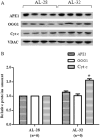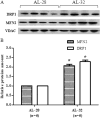"What makes some rats live so long?" The mitochondrial contribution to longevity through balance of mitochondrial dynamics and mtDNA content
- PMID: 27620821
- PMCID: PMC5922457
- DOI: 10.1016/j.exger.2016.09.010
"What makes some rats live so long?" The mitochondrial contribution to longevity through balance of mitochondrial dynamics and mtDNA content
Abstract
Extremely interesting for aging research are those individuals able to reach older ages still with functions similar to those of younger counterparts. We examined liver samples from ad libitum-fed old (28-month-old, AL-28) and ad libitum-fed very old (32-month-old, AL-32) rats for a number of markers, relevant for mitochondrial functionality and mitochondrial DNA (mtDNA) content. As for the mtDNA content and the protein amounts of the citrate synthase and the antioxidant peroxiredoxin III there were no significant changes in the AL-32 animals. No significant longevity-related change was found for TFAM amount, but a 50% reduction in the amount of the Lon protease, responsible for turnover of TFAM inside mitochondria, characterized the AL-32 rats. No longevity-related change was observed also for the amounts of the mtDNA repair enzymes OGG1 and APE1, whereas the intra-mitochondrial amount of the cytochrome c protein showed a 50% increase in the AL-32 rats, indicating a likely reduced initiation of the intrinsic apoptotic pathway. Totally unexpected was the doubling of two proteins, very relevant for mitochondrial dynamics, namely MFN2 and DRP1, in the AL-32 rats. This prompted us to the calculation of all individual fusion indexes that grouped together in the AL-32 rats, while in the AL-28 animals were very different. We found a strong positive correlation between the fusion indexes and the respective mtDNA contents in two AL-28 and four AL-32 rats. This supports the idea that the limited prevalence of fusion above a still active fission should have ensured a functional mitochondrial network and should have led to a quite narrow range of high mtDNA contents, likely the best-suitable for extended longevity. Our findings strongly suggest that, among the multiple causes leading to the longevity of the AL-32 rats, the maintenance of an adult-like balance of mitochondrial dynamics seems to be very relevant for the regulation of mtDNA content and functionality.
Keywords: Aged liver mitochondria; Fusion index correlation with mtDNA content; Long-living rats; Mitochondrial dynamics; mtDNA and related proteins.
Copyright © 2016 Elsevier Inc. All rights reserved.
Conflict of interest statement
The authors have no actual or potential conflict of interest associated with this research.
Figures






References
-
- Aquilano K, Baldelli S, Pagliei B, Cannata SM, Rotilio G, Ciriolo MR. p53 orchestrates the PGC-1α-mediated antioxidant response upon mild redox and meta-bolic imbalance. Antioxid Redox Signal. 2013;18:386–399. http://dx.doi.org/10.1089/ars.2012.4615. - DOI - PMC - PubMed
-
- Bakala H, Delaval E, Hamelin M, Bismuth J, Borot-Laloi C, Corman B, Friguet B. Changes in rat liver mitochondria with aging. Lon protease-like reactivity and N(epsilon)-carboxymethyllysine accumulation in the matrix. Eur J Biochem. 2003;270:2295–2302. http://dx.doi.org/10.1046/j.1432-1033.2003.03598.x. - DOI - PubMed
-
- Baker DJ, Hepple RT. Elevated caspase and AIF gene expression correlate with progression of sarcopenia during aging in male F344BN rats. Exp Gerontol. 2006;41:1149–1156. http://dx.doi.org/10.1016/j.exger.2006.08.007. - DOI - PubMed
-
- Betik AC, Thomas MM, Wright KJ, Riel CD, Hepple RT. Exercise training from late middle age until senescence does not attenuate the declines in skeletal muscle aerobic function. Am J Phys Regul Integr Comp Phys. 2009;297:R744–R755. http://dx.doi.org/10.1152/ajpregu.90959.2008. - DOI - PubMed
-
- Bota DA, Van Remmen H, Davies KJA. Modulation of Lon protease activity and aconitase turnover during aging and oxidative stress. FEBS Lett. 2002;532:103–106. http://dx.doi.org/10.1016/S0014-5793(02)03638-4. - DOI - PubMed
Publication types
MeSH terms
Substances
Grants and funding
LinkOut - more resources
Full Text Sources
Other Literature Sources
Medical
Molecular Biology Databases
Research Materials
Miscellaneous

